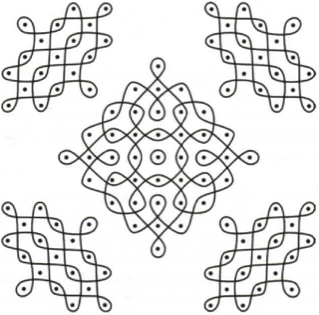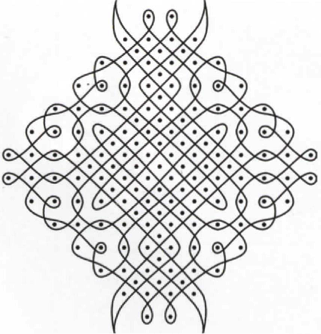Ketki Dhanesha, Shashikala Sathyamurthy, Samir Bellare, Pallavi Naik: Kolam
Artist(s):
Title:
- Kolam
Exhibition:
Creation Year:
- 2008
Medium:
- Rice flour
Category:
Artist Statement:
Kolam is a traditional Indian art form, executed by women, in which drawings are made at the entrances of the home. Known as Kolam in the south and Rangoli in the north, the drawings can be associated with the beginning of a celebration, an honor to a deity or other religious event, or simply to commemorate the beginning of a new day.
Kolams are symmetric geometric patterns. Drawing them implies following precise procedures. Dots (pulli) are drawn first, and then straight lines or continuous curves (neli) are drawn around the dots to make the desired patterns. Different designs could be drawn with the same set of dots.
The tradition and craft for drawing these algorithmic patterns is passed from mothers to daughters and has been for centuries. In South India, Kolams are created with rice flour. Colored powder is used in North India to draw Rangoli. Beyond being a way for women to display their drawing skills, this daily ritual is a representation of the women’s agency and gender role in Indian society, in addition to being a means for personal expression.
Through these ephemeral yet cyclical drawings, it is the women who invite and “communicate” with the outside world and the deities. Kolams, in essence, are a sort of painted prayer. Many women dedicate their Kolams to Lakshmi, the pan-Indian goddess of prosperity, fertility, and protection of the home. These drawings are also signs of invitation to the women’s homes and symbols to prevent evil spirits from entering. Besides functioning as decoration, Kolams also serve as food source for ants and other insects thus inculcating a habit of caring for other lives.
The month of Margazhi (15 December – 15 January) is considered special for those interested in the art of Kolams. Early in the morning during Margazhi, the ground in front of the houses is cleaned and neighbors compete to draw the largest and most beautiful Kolam. It is common in India to hold these competitions throughout the year.
Kolam designs have found their way into contemporary art and design forms such as clothing and jewelry, and they continue to be an integral part of the Indian culture. The generative aspect of Kolam creation has been researched by architects, computer scientists, and others.







